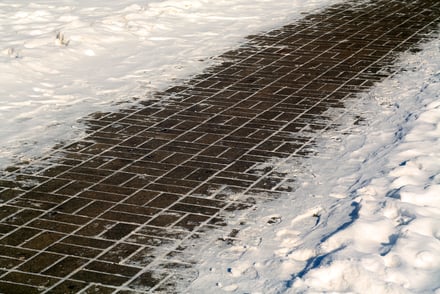As the harsh weather of winter approaches, owners of historic brick homes in the DC area prepare for ice and snow on brick walkways. Homeowners are often challenged by the need to maintain safe walkways while protecting the brick. Using salt or other chemical de-icing products to remove ice and snow from brick walkways can damage and stain the bricks, degrade the mortar joints and harm any nearby vegetation.
A shovel is probably the safest tool to use when removing snow and ice from brick steps and walkways, but sometimes it is not enough. As a safe alternative to chemical or salt application, sand can be used to help.
Another reliable tool is a small home snow blower, which usually come with rubber paddles that will not damage brick pavers. If the pavers are lifting – a common occurrence due to ground frost - contact masonry contractors in DC for repair or restoration before winter.
Occasionally homeowners decide to use de-icing products to remove snow and ice from brick walkways. Here is the information that should be considered:
What are chemical de-icing products and how do they work?
There are four primary de-icing salts for ice and snow removal. Some of these are less damaging than others.
- Magnesium chloride is the newest deicing salt. It continues to melt snow and ice until the temperature reaches -13 F. The salt releases 40% less chloride into the environment than either rock salt or calcium chloride. It is far less damaging to concrete and plants. BEST Choice
- Potassium chloride is not a skin irritant and does not harm vegetation. It only melts ice when the air temperature is above 15 F., but when combined with other chemicals it can melt ice at lower temperatures. GOOD choice.
- Calcium chloride is another deicing salt. It comes in the form of rounded white pellets. It can cause skin irritation if your hands are moist when handling it. Concentrations of calcium chloride can chemically attack concrete. Use CAUTION.
- Sodium chloride also known as rock salt, is the most common deicing salt. Rock salt releases the highest amount of chloride when it dissolves. Chloride can damage concrete and metal. It also can pollute streams, rivers, and lakes. AVOID.
Note: Products containing ammonium nitrate and ammonium sulfate should never be used since these will break down even the most durable masonry materials.
Are there safer ways to use a de-icing product?
Here are several suggestions to help speed melting and minimize damage to masonry when using a de-icing product:
- Follow the manufacturer’s instructions for use and safety.
- Before applying, shovel and remove as much snow and ice as possible.
- Apply the product sparingly in the area of highest foot traffic.
- Apply the product away from the base of the building.
- Mix sand with the de-icing product.
- In the spring, wash down sidewalks, steps, and areas near vegetation to help disperse the residue of the product.
Source: New York Landmarks Conservancy:
Renaissance Development, a leader in brick restoration and historic preservation, is a leader in masonry contractors in DC who specialize in in brick restoration and repair. If your brick walkways and steps need repair, contact us.
Dec 6, 2016 8:30:00 AM



